Kente Cloth: History, Meaning, and Symbolism
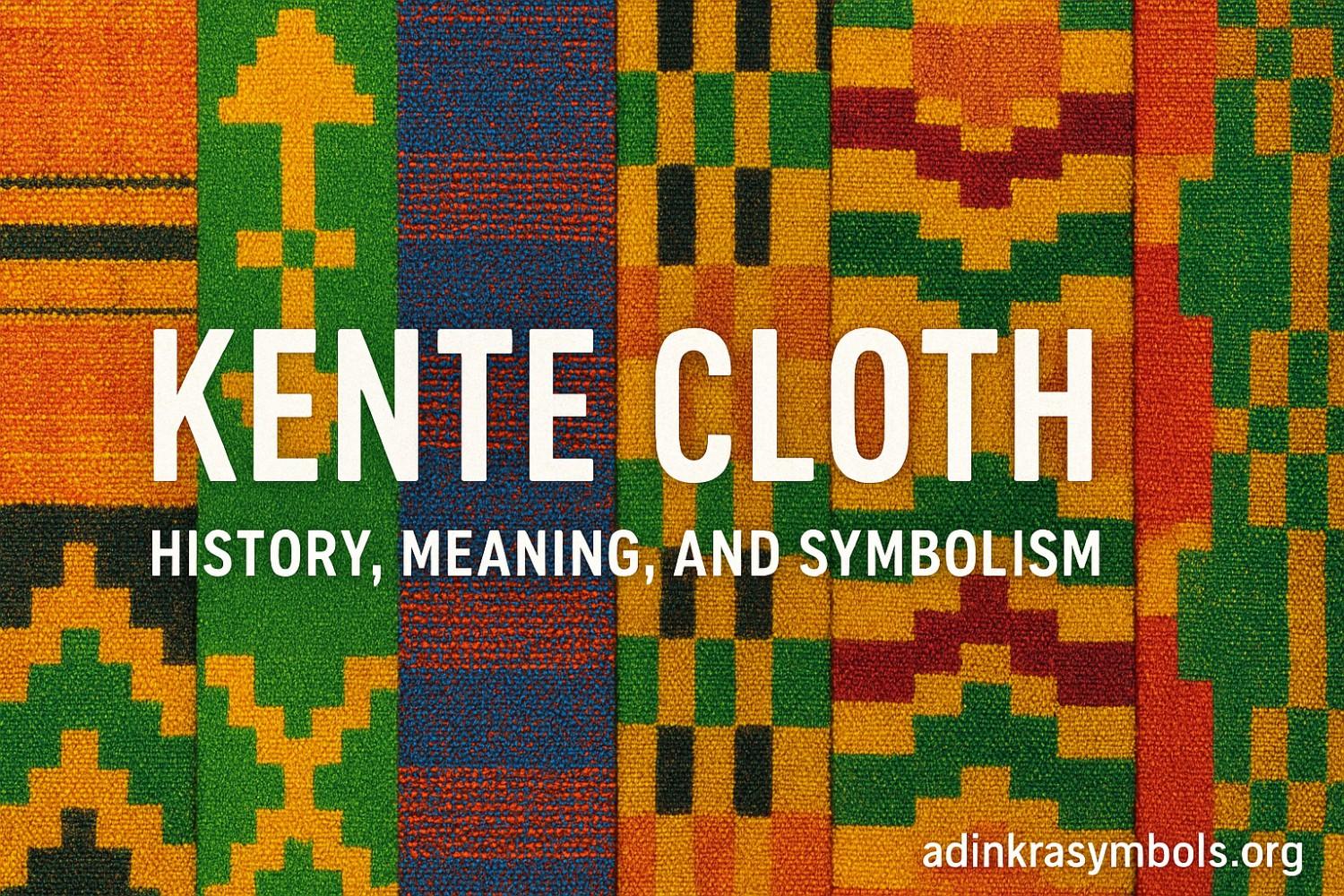
What is Kente cloth?
Kente is one of the most recognizable textiles in the world—a brightly colored, handwoven fabric from Ghana, admired for both its beauty and symbolism. To wear Kente is more than fashion: it is a declaration of identity, status, and cultural pride. Each pattern, color, and arrangement tells a story. Understanding Kente means engaging with centuries of Ghanaian heritage, artistry, and philosophy.
The origins and history of Kente
The word “Kente” comes from the Akan word “kenten” (Twi spelling: kɛntɛn) meaning “basket”, referring to the similarity between the craft of weaving the fabric, as well as its texture, and that of woven baskets.
- Akan tradition holds that Kente weaving began in the 17th century with the Asante people in Bonwire (pronounced bone-wee-ray).
- According to legend, two brothers, Opoku Kuragu and Kwakye Ameyaw, observed a spider weaving its web and applied the same technique to fibrous materials like raffia from palm trees to create the first Kente.
- Historically, Kente was reserved for royalty and sacred occasions, woven on narrow looms and stitched into large wraps.
Today, it has expanded globally, worn in graduations, weddings, and diasporic ceremonies as a symbol of African identity.
The art of Kente-weaving
Kente is woven in narrow strips (about 4–5 inches wide) on traditional looms (called nsannua in Twi). These strips are then sewn together to create larger cloths.
- Weavers are often men, trained from a young age.
- Patterns are created by alternating colored threads in precise sequences, a craft requiring both artistry and mathematical precision.
- The process is slow and deliberate—one Kente cloth may take months to complete.
This craftsmanship makes every Kente cloth unique, each one bearing the imprint of its maker.
The names and meanings of some kente cloths and patterns
The motifs and patterns in Kente have names and proverbs tied to philosophy, values, and historical events. The patterns, like proverbs, are multi-layered. Wearing one is both an aesthetic choice and a public statement. Below are some examples.
Fathia Fata Nkrumah, originally Baako Mmu Man
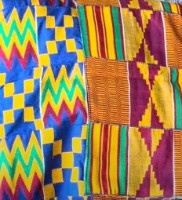
This is a very popular Kente cloth which comes in many colors. It was originally called Baako Mmu Man–one person does not govern a nation–but was later named for Madam Fathia Nkrumah, the wife of Kwame Nkrumah, the first president of the Republic of Ghana.
The distinctive features of this cloth are the following patterns.
- Mpuankron (nine tufts of hair)
- Nkyinkyim (twisting, zigzag)
- Knemfere (potsherd)
- Apremo (canons)
Sika Fre Mogya
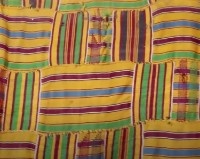
Sika Fre Mogya literally means “Money invites blood or money calls blood” Blood here represents one’s relatives. Thus, this cloth is a statement about how one’s relatives may abandon him when he has nothing to offer but suddenly flock to him when they can get some benefit from him.
Adwini Asa
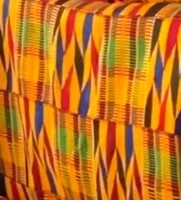
Adwini Asa literally means “Designs are finished.” Having run out of designs after using them in designing various cloths, kente weavers, in an attempt to develop something new, came up with this mixture of designs to achieve novelty.
Emmaa Da
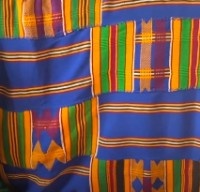
Emmaa Da literally means “It hasn’t come before.” This cloth was given that name because at the time it was designed it had not precedent. As Kente creftsmanship blossomed, new dyes and colors were added to the repertoire of the weavers to supplement the original red, gold, green, and black that they had already discovered. When blue was added and used to design the cloth, it elicited showers from patrons and connoisseurs praising its novelty, hence, the name.
Obi Nkyere Obi Kwan Mu Si
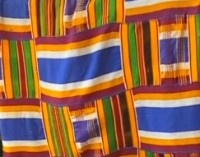
Obi Nkyere Obi Kwan Mu Si (Twi spelling: Obi Nkyɛre Obi Kwan Mu Si) literally means “It doesn’t take long for someone to cross another’s path.” The figurative meaning of this expression is that we are bound to hurt each other so let’s be quick to forgive.
The patterns in the cloth dhow alternative blocks of downward stripes and stripes that go across in the transverse direction.
Kente and Adinkra: shared symbolism
Kente and Adinkra are often paired. While Adinkra symbols communicate ideas through printed motifs, Kente communicates through woven color and form.
- Both are rooted in Akan philosophy.
- Both carry messages of morality, identity, and spirituality.
- In Ghanaian ceremonies, it is common to see Adinkra cloths and Kente cloths worn together, creating a dialogue of symbols.
This pairing shows that Ghanaian textiles are not just decoration — they are visual languages.
The global significance of Kente
Kente has gained global acclaim, transcending its origins to become a pan-African emblem. From Black liberation movements to graduation ceremonies in the U.S. and Europe, it serves as both a cultural anchor and a contemporary statement of identity.
- In the diaspora, wearing Kente reconnects people of African descent with their ancestral roots. For example, it is now common for graduates to wear Kente stoles during commencement ceremonies.
- In politics, leaders have used Kente to assert African pride and solidarity, as when members of the Democratic Party in the U.S. donned Kente stoles while kneeling at the Capitol in a civil rights gesture.
- In art, fashion, and design, Kente’s vivid patterns inspire high fashion, architectural projects, and everyday creative expression worldwide.
Thus, Kente is more than a cloth: it is a unifying symbol for Africans everywhere, bridging heritage with modern identity.
Conclusion
Kente cloth is more than fabric. It is history woven into art, philosophy stitched into color. Its threads carry the wisdom of ancestors and the pride of a people. To learn Kente is to enter into Ghana’s heritage, and to wear it is to speak a cultural language without words.
References
-
Documentary by Real People Real Places
This documents a visit to the Kente Export Village at Bonwire. One weaver demonstrates the weaving of a plain weave cloth. He describes how the loom is set up with the warp, heddles, and beater. he also describes the process of weaving a double or triple weave cloth.
Master weaver Akwasi Kwarteng presents the history of kente and gives the names of some cloths: agyegyensu, emmaa da, sika fre mogya, ohene aforo hyen, Fathia fata Nkrumah, mmere pa da w’anim, sika futuro, adwini asa, oyoko mmaa adwini asa
-
Documentary by The Open University
Nana Kwasi Gyamfi, Kentehene of Bonwire, gives the names of some cloths (baako mmu man, aka Fathia fata Nkrumah, and abusua ye dom) and the history behind the names.
Nana Asante Frempong, master weaver, gives the names of baako mmu man and explains how it came to be known as Fathia fata Nkrumah.
Akwasi Akwaboah, a master weaver, answers some questions on the weaving process such as where ideas for designs come from, how much effort it takes to weave a cloth, as well as the varieties of thread used as inputs to the process.
He also provides the names of the patterns in a piece of cloth of the adwini si adwini so (design sitting upon a design) type he had woven. The patterns in the particular cloth he describes are owuo atwedee (death’s ladder), akyem (shields), nanka tire (python’s head), afofanto (butterfly)
Finally, Osei Antobre, a master weaver and Kente merchant, gives the story behind a cloth he named Breguo Ye Ya, literally, “Wasted effort is painful.” The story is that he had a son he saw through medical school but who passed away shortly after completing school, bringing all the invenstment he the father had made in him to nothing, hence the name.
-
Master weaver Akwasi Kwarteng gives the history of Kente cloth and the names of some cloths and patterns.
The cloths discussed are oyoko mmaa ntoma, which has the following patterns: nkyinkyim, afa, and fa ohia kotwere Agyeman; kyeretwie, literally one who catches a leopard, named after Asantehene Nana Osei Kyeretwie; sika fre mogya; ohene aforo hyen; Toku akrantoma (Toku’s farewell cloth); emmaa da; ohemaa aba Ghana; sika fre mogya
Glossary of kente terms
- awhepan - plain weave or single weave
- faprenu - double weave
- di adwini - to design
- asa - heddle
- nsadua - loom
- nkyinkyim - zigzag
- edoa - raffia
- ntomaban - strip of cloth
